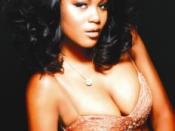How Far Will They Go?
If one were to type the phrase 'Bahamian beauty' into the renowned search engine Google, the following images would appear:
Figure. 1. Tonique Williams-Darling,
photographed at a luxurious Island House
Beachfront Residence in Ocean Club Estates Figure. 2.
Neglecting the fact that these women are indeed stunning, with their evenly toned, glossy skins and lengthened hair, would be quite ludicrous. However, to imply that they are a sample representation of the entire population of Bahamain women is even more so. These women, instead, portray an image of desirability and to a certain extent are unattainable, simply because every individual is unique. They represent a goal that most Bahamian women strive for because they are constantly bombarded with the notion that a woman is not desirable unless flaunting long, lustrous hair, luminous, flawless skin and unattainable idealized body figures. This belief induces women to resort to any extent necessary to achieve an imitation of the images, (figures 1 and 2) provided above.
It is evident that the media plays an important and destructive role in influencing the attitudes of women towards beauty, especially in the Bahamas.
In her article entitled 'Perceptions of Beauty and Identity: The Skin Bleaching Phenomenon in Jamaica,' Petra Robinson makes the assertion asserts that because of the messages depicted in the media, individuals believe that the lighter one skin is, the higher their social status.
The opinion that light skin is attractive, and especially more attractive than dark skin, is permeated throughout the media. This message is extended in mass media, throughout the community, and continues to reverberate among people across all age groups. As a result of this idea that light skin is more attractive than dark skin, the evidence of it being a marker of social status, and that...


